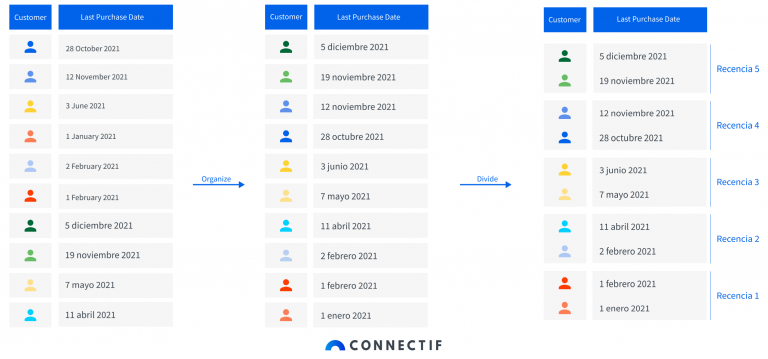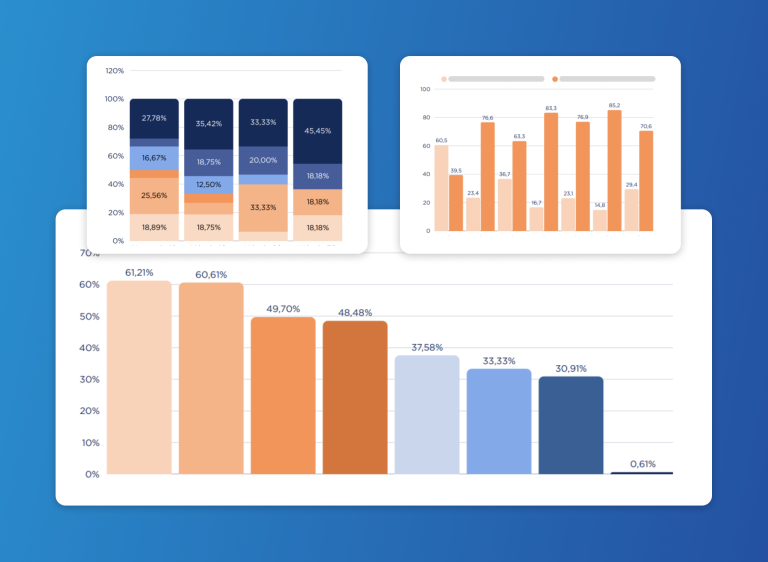RFM is a marketing technique that allows you to segment your audience according to their relevance to your business. This is done based on three criteria: Recency, Frequency and Monetary Value. RFM analysis is one of the most efficient methods to identify high-value targets and increase conversion rates. In this post we’ll cover how to use and calculate this advanced metric in order to improve your marketing and sales results.
What does RFM stand for?
RFM (as in Recency, Frequency, Monetary) is a marketing technique used to analyze customer value based on three variables:
- Recency: number of days since the last purchase or order.
- Frequency: average orders during a certain period (for instance, number of monthly purchases).
- Monetary value: total order amount during a specific time frame.
RFM models assign a score to every client according to these three variables. A ranking is then created. This allows you to create client segments based on their strategic business value, boosting your marketing strategy.
What is it used for?
RFM became popular in mailing marketing during the 60s. This technique is still being used nowadays, but applied to digital services and used to influence hundreds (and even millions) of eCommerce clients.
It is a very useful method indeed! It provides answers to questions as…
- Who are your best clients?
- Who are your most loyal customers?
- Which clients are about to leave?
- Who should be considered a “lost” client?
- Which clients are worth the extra effort?
- Which client segment will react favorably to your current/next campaign?
The answers to these questions are the starting point for new strategies focused on reaping the following benefits:
- Higher efficiency: marketing actions (and their impact) are optimized.
- Higher conversion rates: CVR increases.
- Better loyalty-building practices: customer retention improves.
- More interaction: response rates increase.
- More revenue: sales are boosted.
How does it work?
To put it simply, RFM analysis takes three key customer variables into account to create a ranking that groups customers according to their business value.
This means that if a client recently completed a purchase (Recency), they will get more points. If they made multiple purchases (Frequency), they will be placed higher. And if they spent a bigger amount of money on their orders (Monetary value), they will also have a higher score. When we combine these three factors, we can create a RFM ranking.
Let’s take a closer look. RFM is a quintile-based method: it divides an object into five equal parts. For instance: Recency can be estimated by sorting customers by purchase date and dividing the resulting list into fifths.
Quintiles can be used to strategically segment our audience, thus applying newer and more effective marketing actions.
How are client rankings designed?
The main idea is to assign a score (based on RFM parameters) to every customer. Our top clients will have a 555 score. Bottom customers will have the lowest rating: 111.
Based on these results, eCommerce sites are able to adjust their marketing strategy and adapt it to strategic audience segments to gain impact, increase profitability and improve marketing efficiency.
RFM Segmentation & Strategic Segment Planning
RFM segmentation is especially useful for eCommerce platforms, as it allows the company to identify different customer segments based on their actual behavior and to implement more profitable strategies.
The chart below shows segment terminology, behavior details and potential marketing strategies for each audience type.
| Client Segment | RFM | Behavior | Potential
Strategies |
| Champion | 555, 554, 544, 545, 454, 455, 445. | Completed a recent purchase. They buy frequently and spend the most. | Reward them. Can be early adopters of new products. They act as brand ambassadors. |
| Loyal Customer | 543, 444, 435, 355, 354, 345, 344, 335. | They buy frequently and spend a lot of money on the site. Sensitive to offers. | Upsell. Offer high-value items to them. Ask them for reviews. Build loyalty. |
| Potential Loyalist | 553, 551, 552, 541, 542, 533, 532, 531, 452, 451, 442, 441, 431, 453, 433, 432, 423, 353, 352, 351, 342, 341, 333, 323. | They recently spent a fair amount of money on the site more than once. | Invite them to join a loyalty program or to get a membership. Recommend other products to them. |
| New Customer | 512, 511, 422, 421 412, 411, 311. | Completed a recent purchase, but doesn’t order often. | Support them on their onboarding process. Get their satisfaction. Start to build loyalty. |
| Promising | 525, 524, 523, 522, 521, 515, 514, 513, 425,424, 413,414,415, 315, 314, 313. | Completed a recent purchase, but didn’t spend a lot. | Create brand awareness. Offer discounts, gifts
and free trials. |
| Need Attention | 535, 534, 443, 434, 343, 334, 325, 324. | Above average in recency, frequency and monetary value, but no recent purchases. | Launch limited-time offers and recommendations based on previous orders. Reactivate. |
| Cannot Lose Them | 155, 154, 144, 214,215,115, 114, 113 . | Completed huge, frequent purchases long ago but haven’t come back since then. | Get them back with new product launches. Don’t let competitors take them. Talk to them. |
| About To Sleep | 331, 321, 312, 221, 213. | Below average in recency, frequency and monetary value. At risk of losing them if you don’t reactivate. | Share useful information. Recommend popular products to them. Offer new discounts. Reconnect. |
| At Risk | 255, 254, 245, 244, 253, 252, 243, 242, 235, 234, 225, 224, 153, 152, 145, 143, 142, 135, 134, 133, 125, 124. | Completed big, frequent purchases long ago. You need to bring them back! | Send personalized emails to reconnect with special offers. Share useful resources with them. |
| Hibernating | 332, 322, 231, 241, 251, 233, 232, 223, 222, 132, 123, 122, 212, 211. | Their last purchase was long ago. The number of orders was small and the amounts spent low. | Offer relevant products and special discounts. Create brand value again. |
| Lost | 111, 112, 121, 131, 141, 151. | Lowest scores in recency, frequency and monetary value. | Try to reactivate them with personalized campaigns. If it doesn’t work,
ignore them. |
Once RFM segments are established, client distribution will look somewhat similar to what you see on the chart below.
Keep in mind that proportions are illustrative, as audience segments are alive! This means that customers are dynamic and can jump from one category to another.
How to automatically estimate your RFM with Connectif
RFM rankings are a highly strategic asset for any eCommerce site. However, estimating them manually can be complex and takes a lot of time. That’s why many platforms tend to ignore this important metric.
Using Connectif, you can automatically estimate your RFM with precision. Our technology takes this effective analysis method and applies it to your data, turning it into useful information for your marketing team. This can make a big difference and make you stand out from your competitors.
Want to see how Connectif can boost your strategy? Request a demo now!
Don’t forget that intelligent audience segmentation is the foundation of an effective marketing strategy. Group your customers according to strategic criteria and make the most out of your contacts. Your marketing team will be key to boost your revenue.







